
Intel’s K-series desktop CPUs always get the most attention from enthusiasts because they represent the best performance that new Intel processors are capable of when money, heat, and power are no object. But more people will end up using the cheaper, non-overclockable versions of these processors, whether it’s in an office desktop PC, a budget gaming desktop, or a price-conscious home video editing workstation.
Today, we’re taking a look at the Core i7-12700, a 12-core, 20-thread CPU that retails for around $340 (or $315 without integrated graphics). That’s anywhere from $75 to $100 cheaper than the overclockable Core i7-12700K, plus whatever money you save by buying a cheaper H670 or B660 motherboard rather than a pricey Z690 model.
We came away impressed with the i7-12700's performance but mixed on its power efficiency, as was the case when we reviewed some K-series CPUs last year. The good news is that home PC builders can usually decide for themselves whether they want to maximize performance or prioritize power efficiency and heat output. Using Intel's recommended power settings, the i7-12700 can actually be quite well-behaved. Just know that most motherboard makers' default power settings prioritize performance even if it makes your desktop hotter and more power-hungry.
Intel CPU power settings explained
Much of this review will discuss how Intel’s CPU power limits work, so let’s start by laying out the terminology. This will be especially relevant to anyone who hasn’t built a computer in a few years.
Intel and AMD have both fought over the last half-decade to cram an ever-increasing number of cores into their mainstream desktop processors. Taking Intel as an example, its i7 processors went from four to six to eight cores between the seventh and ninth generations, and a new i9 tier with 10 cores was also introduced above those. These chips were all made using lightly tweaked iterations of the same Skylake CPU architecture and lightly tweaked iterations of the same 14 nm manufacturing technology.
The result is that power budgets have gone way up, and when chips are running at full-tilt, actual CPU power consumption is substantially above the 65 W TDP that Intel has listed on its desktop CPU product pages for years.
To its credit, with its 12th-generation chips, Intel has thrown out “TDP” in favor of a Processor Base Power (PL1) number and a Maximum Turbo Power (PL2) number. PL1 is more or less what TDP used to be—the amount of power and cooling capacity a CPU is expected to require to operate at its rated specs when under sustained load for more than a couple of minutes at a time. The PL2 number is the true maximum power consumption number, the one you’ll see when running tasks for short periods or for apps like web browsers and games that don’t require 100 percent of your CPU’s performance 100 percent of the time.
The wrinkle is that those PL1 and PL2 ratings are suggestions rather than hard-and-fast requirements, allowing motherboard makers to set different limits if they really want to. For enthusiast-y boards, this usually means boosting both numbers into the stratosphere or removing the limits entirely in the name of increased performance. The Gigabyte Z690 board I used for some tests has default power limits set at over 4,000 W. A CPU actually drawing that much power would, of course, melt a hole deep into the Earth’s mantle, but the point is that the processor can use as much power as it and the motherboard can physically handle unless it’s hitting its thermal limits.
The upside of flexible, user-configurable PL1 and PL2 limits is that they effectively enable a sort of “overclocking” for non-K-series CPUs running in non-Z-series motherboards. Our benchmark results show clear benefits to upping the default power limits of the i7-12700K, moving its performance from “competitive with AMD’s Ryzen 7 5800X” to “stomping the 5800X.”
The problem is that more power generates more heat, which requires either better cooling or letting your CPU run at higher temperatures, which can shorten its useful life. In some cases, you might actually lose a bit of performance because the extra heat leads to thermal throttling. And the performance benefits that you get aren’t really commensurate with the extra power you’re using. In our tests, when thermal throttling isn’t an issue, the i7-12700 used roughly twice the power to deliver somewhere between 25 and 40 percent better performance.
This is a meaningful speed improvement, but it comes at a cost.
reader comments
138